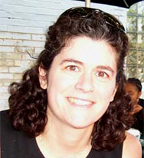Organisms precisely regulate cell size to ensure that daughter cells have sufficient cellular material to thrive or to create specific cell types: a tiny sperm versus a gargantuan egg for example. In single-celled organisms such as yeast and bacteria, nutrient availability is the primary determinant of cell size. In animal cells, size is controlled in large part by a molecule that senses the blood sugar-dependent hormone insulin.
Petra Levin, Ph.D., Assistant Professor of Biology at Washington University in St. Louis, and her laboratory have recently identified a trio of enzymes that act in concert to link nutrient availability to cell size in the soil bacterium Bacillus subtilis.

Levin and her lab are looking into the factors that control the timing and position of cell division in B. subtilis. B. subtilis serves as the model system for a large family of bacteria that includes the causative agents of several important diseases, including anthrax and botulism. By learning how these simple organisms regulate division, she hopes to better understand why this process goes awry in cancer cells resulting in uncontrolled growth and aberrant division.
A primary focus of the Levin lab’s research is a protein called FtsZ. FtsZ is an ancestor of tubulin, the protein that is responsible for distributing duplicated chromosomes between dividing human cells. In bacteria, FtsZ forms a ring at the future division site. The FtsZ ring then recruits all other components necessary for cell division and serves as the scaffolding for the entire division process.
The factors that regulate FtsZ ring formation determine when and where the cell is going to divide. “Theoretically a cell could divide anywhere and at anytime,” said Brad Weart, a graduate student in Levin’s lab. “The cell has to very precisely restrain that process so that it only happens when and where the cell wants it to happen.”
In their most recent paper, published in the July 27, 2007 issue of Cell, Weart et al. identified a metabolic sensor that links cell division and cell size in B. subtilis with nutritional availability. This sensor is comprised of a three enzyme pathway that was previously shown to be involved in synthesizing a modified component of the cell membrane. The Levin lab’s data indicates the pathway also has a major role in cell division. “So far this has been the only pathway that’s been identified in bacteria that directly regulates cell size,” says Levin.

Typically, cells in nutrient-rich environments grow bigger than cells in nutrient-poor environments. The Levin lab determined that mutations in genes encoding the three enzymes resulted in cells that were small even when they were in a nutrient-rich environment. “Basically, the cells had no way to tell the division apparatus to wait until they’ve reached the size they should be. The cells would divide when they were still very short,” said Levin. “It was almost as if they were growing in really great media but they didn’t know it.”
Knowing when to divide
Further work indicated that the mutation perturbed FtsZ ring formation. In the cell, FtsZ exists in a balance between its unassembled and assembled state. The enzyme trio regulated FtsZ ring formation by changing this balance — pushing FtsZ towards its unassembled state when the cells were growing in nutrient-rich conditions, thereby delaying cell division and increasing cell size.
All three enzymes in the pathway are sensitive to glucose levels, and the pathway is therefore well suited to communicating nutritional information directly to the cell’s division apparatus. In nutrient-poor conditions the enzymes no longer inhibit FtsZ assembly, allowing the FtsZ ring to form when the cells are still small, resulting in the formation of smaller daughter cells. The third enzyme in the pathway, UgtP, physically interacts with FtsZ to prevent ring formation. UgtP responds to low levels of glucose (nutrient-poor conditions) by becoming unstable and forming what appear to be inactive aggregates.
Disrupting this pathway leads to defects in chromosome segregation. A cell that is too small is unable to effectively move its DNA away from the division site and the resultant daughter cells frequently do not contain all the genetic material that they should. By coordinating cell size with growth rate, cells are able to maintain proper distribution of DNA.
This work is also something of a cautionary tale about the limitations of genome sequencing. “More and more often we are finding that metabolic enzymes have more than one function,” said Levin, “There is no hint from their sequence that they have other activities so you really need to delve deeper and apply different methods to identify them.”
Levin notes that her research is uncovering just the “tip of the iceberg” in the field of cell size control, but identifying genes such as ugtP helps Levin and other researchers get a better handle on precisely what determine how big a cell will be.